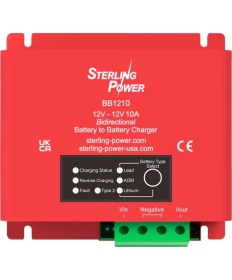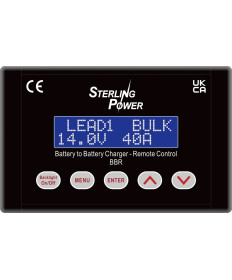Charging booster 12V/12V 10A - Sterlingpower
Battery to Battery DC-DC 12/12V - 10A - 140W
- Ideal for trailers or cigarette plugs
- Battery voltage 12V, charging power 140W - 10Amp.
- 4 charging profiles, 2x lead-acid, 2x AGM, incl. temperature sensor
- 2 charging profiles lithium
- Activation: signal, voltage, vibration
- Recharge and JumpStart Assistant
Sterling Power B2B battery charger
A very high efficiency of up to 98% thanks to the latest buck-boost technology. This also guarantees
a permanently high performance of the device without overheating.
Charging characteristic
There are 6 adjustable charging characteristics (2x lead-acid, 2x AGM, 2x lithium). An individual
characteristic curve (in conjunction with the remote control) can also be programmed (except for the BB1225).
The service battery is charged with a 4-stage characteristic curve (IUoUo), which has proved very successful and
guarantees a fully charged battery. The charging voltage is adapted to the temperature of the battery (if a temperature sensor is installed). (voltage compensation)
There is no temperature-voltage compensation for lithium batteries.
The devices are almost noiseless.
As little waste heat is generated, the fans rarely switch on (25A without fan).
Due to the very high efficiency, only little heat is generated. The fans are temperature-controlled.
Bidirectional (reverse) charging (of the starter battery)
Reverse charging of the starter battery ensures a full battery when the
service battery is charged by an external charging source (solar, wind generator or charger).
The battery is charged with a constant voltage (U characteristic) of 13.3V (= trickle charge).
Simple installation (activation by voltage, vibration or signal)
Various types of activation possible. Either via a signal input (z.B. ignition signal)
or via the input voltage (as soon as an increased voltage - charging voltage - is detected on the
starter battery, the device switches on) or via the detection of vibrations (engine).
Lithium battery compatible
Selecting the special lithium characteristic curve ensures that the temperature
compensation is deactivated and no charging takes place at a battery temperature of below 0°C.
Individual programming of the battery charge is possible with the remote control (accessory).
Euro 6/7 and Smart alternators compatible
Compatible with all Euro 6 and Euro 7 vehicles. If the voltage is too low, the
Device can be activated via a signal input (z.B. ignition plus) or vibration detection.
Emergency start function
If the starter battery is so discharged that the engine can no longer be started,
the emergency start function can be activated. The starter battery is charged for a short period of time, independently
of the voltage of the consumer battery, so that the engine can be started.
Temperature sensor included (adjusted voltage for lead/acid and AGM batteries)
The temperature sensor supplied protects the battery from overheating and adjusts the
charging voltage (lead/acid and AGM) to the ambient temperature of the battery.
Small design and low weight
CE and e-approval
The optional remote control can be used to adjust functions and display current values.
* Current voltage and current of the battery output
* Adaptation to an individual charging profile
* Current limitation to 100%, 85% and 65%
* Switching trickle charging on/off for lithium batteries
* Equalization charging and desulphation setting can be adjusted and switched on.
EV - Electric Vehicle Compatible
- 3 reasons for installing a BB instead of direct wiring / relay
Under the hood of electric vehicles is the positive and negative 12 V connection leading from the high voltage/low voltage DC/DC converter to the 12 V battery. Normally there is a positive 12 V busbar and a negative 0 V pole. One of these positive feeds leads to the 12 V battery. The 12 volt terminal leading to the 12 volt battery would be where you install the "BB" along with the common negative terminal.
The high voltage low voltage DC/DC converter is probably current limiting itself. However, the vehicle can use this current, although not always all of it.
Advantages of BB installation with EV
- The BB isolates the EV's 12V battery from the 12V leisure battery, so the 12V EV battery should NOT be discharged.
If you discharge the 12V EV battery, your EV will not start.
- The BB has a maximum current draw. A good estimate is to set the BB to approx. 25-50% of the current of your DC-DC converter
. This allows the converter to supply the current for the mandatory consumers (steering, lighting, stereo, air conditioning, etc.)
and the surplus for the 12 V auxiliary battery. For example, if your converter is rated for 190 A, use a
BB1270 - it supplies ~60/70 A for charging. When the full power of the converter is used by all the auxiliaries, the
voltage in the 12 V system drops and the BB naturally reduces its power and switches off during this high current demand phase.
The BB switches back on when the voltage rises again.
- When charging lithium batteries, the charging power is likely to be exceeded. If your converter is rated for 200 A, but your
lithium battery can only handle 100 A, the converter will try to deliver 200 A, but the BMS of the battery(ies) will switch off.
The advantage of the BB is that it regulates the current to the BB / value you have selected.
- You get the correct charging voltages at the 12 V service battery.
Reverse charging function.
The BB1225, 1240, 12120 are able to charge in both directions. If the leisure battery is above 13.2V (13.5V for lithium) and the starter battery is below 13V, the BB allows around half of the current to flow back to the starter battery until around 13.4V is reached (float voltage). This allows the starter battery to remain charged when the house battery contains excess energy.
This function does NOT discharge your service battery - it simply absorbs excess energy. As soon as the alternator/engine is switched on or you give the BB an ignition signal, the BB returns to normal charging of the service battery.
This is ideal for keeping the starter battery charged when you charge the service battery with solar/wind/chargers.
This mode can be deactivated on the booster, but is switched on by default.
Why should I adjust the current limit?
The default current setting for the BB range is 100% - this means that the power is set to full power by default.
If you want to reduce the power of the BB, you can set 85% or 65% here.
Examples of why you might want to reduce the output:
1) If you have solar panels and the weather is good, you can save fuel by reducing the output of the alternator.
2) The alternator is better off running at a slightly lower amperage than expected.
3) Your battery supplier may advise you to charge the battery at a slightly lower current. If one of your lithium batteries in your leisure battery bank fails, you may exceed the C rating of the remaining batteries.
4) Future proofing. If you have a high-capacity battery installed, you should expect to one day add a larger alternator and/or more batteries to your system. You can reduce the output for the immediate installation and increase the output of the device at a later date.
Connecting multiple battery-to-battery chargers in parallel?
It is no problem to install several BBs in parallel to increase the power.
For example, you can connect a BB1240 in parallel with a BB12120 to obtain a
charging current of 160 A. It is also possible to combine BB1270 with BB1240 or BB12120 etc.
Advantages:
1) Redundancy: Multiple DC-DC chargers can help with redundancy. If one of the devices is damaged, the other BBs will continue to charge.
2) Fine tuning of the current. As each BB has 3 different power levels, by connecting several BBs together you can get 6, 9, 12 etc. different power levels.
For example, if you want 90A, you could buy a BB1270 and a BB1240 and set the power levels to 85% each via the BBR remote control (so you get about 90A). This way you get a high degree of flexibility to set a specific charging current.
Data sheet
- Input voltage
- 9-16V
- Output voltage
- 12V
- Battery voltage
- 12V
- Charging current
- 10A
- Loading algorithm
- mehrstufig, adaptiv
- Output voltage Characteristic
- Ladekennlinie
- Connections
- Phönix Schraubklemme 16mm2
- Protection
- Gerätedefinition nennt Eingangsstrom
- Feature
- Eingangsstrom nennt Geräte definition
- Feature
- Ohne Lüfter - 98% Effizienz
- Feature
- https://youtu.be/iPP2VvYrFcQ
- Feature
- EURO 6 tauglich
- Dimension
- Weight
- Hint
- Gerätedefinition nennt Eingangsstrom
- Hint












